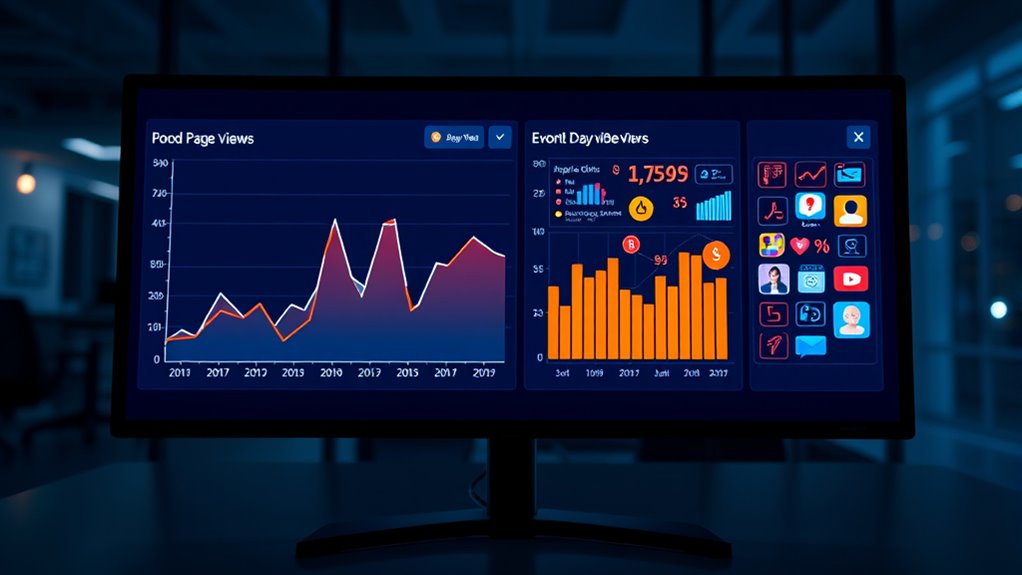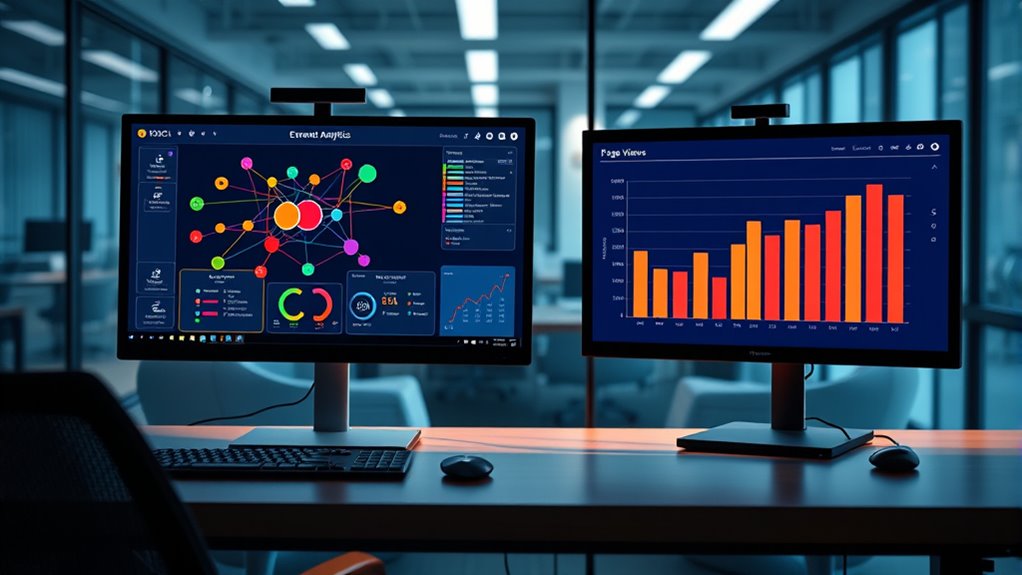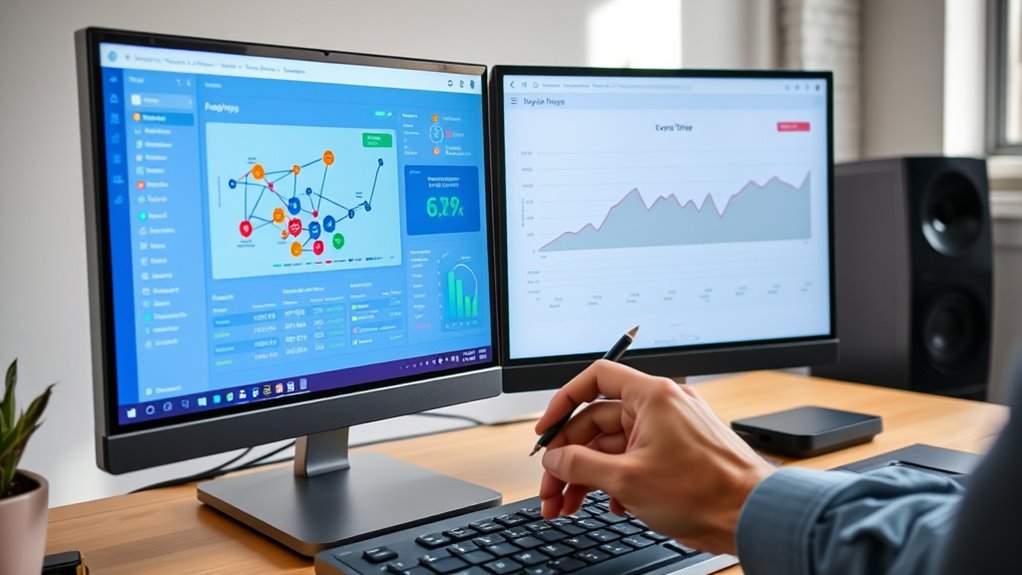Event-based analytics track specific user actions like clicks and downloads, while page-view analytics measure how often pages load or are viewed. Event tracking gives you detailed insights into user behavior, helping you understand high-engagement moments. Page views show overall traffic and popular content. Choosing the right approach depends on your goals, but combining both methods offers a complete picture of your website’s performance. Continue to explore how these tools can work together for better insights.
Key Takeaways
- Page-view analytics track overall page loads, offering high-level website traffic insights, while event-based analytics monitor specific user actions for detailed behavior data.
- Page views can overestimate engagement due to accidental reloads, whereas event tracking provides more precise, granular interaction metrics.
- Page views are ideal for measuring overall performance and content popularity; events are better for understanding user engagement with specific elements.
- Combining both methods yields comprehensive insights into user journeys, content effectiveness, and real-time interaction patterns.
- Choosing between them depends on goals: use page views for broad metrics, event tracking for detailed behavioral analysis.
What Is Page-View Analytics and How Does It Work?
Page-view analytics track how many times individual web pages are loaded or viewed. When you analyze these metrics, you gain insights into user engagement, showing which pages attract the most visitors. This data helps you identify popular content and optimize your website’s layout and messaging for better user interaction. By monitoring page views, you can understand visitor behavior and tailor your content to improve engagement. Content optimization becomes easier when you see which pages perform well and which need improvement. This approach allows you to refine your website’s structure, ensuring users find what they’re looking for quickly. Ultimately, page-view analytics provide the foundational data to enhance user experience and boost overall site performance.
Understanding Event-Based Analytics and Its Functionality
Event-based analytics focus on tracking specific actions or interactions users take on your website, such as clicks, downloads, form submissions, or video plays. This approach allows you to gather detailed insights into user behavior, enabling real-time monitoring of how visitors engage with your content. By analyzing these events, you can segment users based on their actions, creating targeted groups for personalized marketing efforts. Event tracking provides a clearer picture of user journeys beyond page views, helping you identify what drives conversions or drop-offs. With this data, you can optimize website features, improve user experience, and make informed decisions quickly. Additionally, implementing relevant metrics helps measure progress and effectiveness more accurately. Overall, understanding event-based analytics enhances your ability to respond dynamically to user interactions and tailor your strategies effectively.
Key Differences Between Page-View and Event Tracking

While both page-view and event tracking gather valuable data about user interactions, they serve different purposes and offer distinct insights. Page-views mainly measure how many times a page loads, helping you gauge overall user engagement. Event tracking captures specific actions like clicks or downloads, providing detailed insights into user behavior. This difference impacts data accuracy; page-views can sometimes inflate engagement metrics with accidental reloads, while events offer more precise data on interactions. Here’s a quick comparison: content accuracy can be influenced by how each method captures data, affecting the reliability of your analysis.
Benefits of Using Page-View Analytics for Website Monitoring

Using page-view analytics provides a straightforward way to monitor your website’s overall traffic and engagement levels. It helps you identify which pages attract the most visitors, giving you clear insights into user engagement patterns. With this data, you can easily spot popular content and understand visitor behavior across your site. Page-view metrics also support content personalization by revealing what interests your audience most, allowing you to tailor experiences accordingly. This simplicity makes it easier to track trends over time without complex setup. Additionally, you can quickly assess the impact of marketing campaigns or content updates. Overall, page-view analytics offers a reliable, easy-to-understand foundation for maintaining and improving your website’s performance and user experience. Incorporating basic display techniques can further enhance how you interpret and present this data for better decision-making.
Advantages of Implementing Event-Based Analytics for User Insights

Building on the insights gained from page-view analytics, implementing event-based analytics allows you to gather more detailed and specific user interactions. This approach enhances your understanding of user engagement by tracking actions like clicks, downloads, and form submissions. Because events capture precise behaviors, data accuracy improves, giving you clearer insights into how users interact with your site. With this detailed data, you can identify which features resonate most and optimize user experiences effectively. Event-based analytics also enables real-time tracking, helping you respond quickly to user needs. Additionally, understanding individual responses to content can help tailor your strategies more effectively. Overall, it provides a richer, more actionable data set that supports targeted enhancements, increases engagement, and drives better decision-making.
When to Choose Page-View Analytics Over Event Tracking
If your data needs are simple and your website has low interaction levels, page-view analytics might be enough. Basic performance metrics, like total page visits, often don’t require detailed event tracking. In these cases, focusing on page views can give you clear insights without added complexity. Additionally, understanding best anime movies can help you appreciate different storytelling styles, but for straightforward website analysis, page views typically suffice.
Simple Data Needs
When your analytics needs are straightforward—such as tracking overall page visits or measuring how many users view a specific page—page-view analytics often suffice. They offer a simple way to gather basic data without complicating your setup. Since these metrics focus on page visits, they respect user privacy by avoiding detailed tracking, which can be a concern for some audiences. Additionally, page views provide reliable data accuracy for basic insights, helping you understand overall traffic trends. This approach works well when your goal is to monitor general engagement rather than detailed interactions. If your needs are simple and privacy is a priority, sticking with page-view analytics makes sense, saving time and resources while still delivering useful, trustworthy data. Moreover, understanding data accuracy can help determine when page views are sufficient for your reporting needs.
Low Interaction Levels
Low interaction levels often mean that users primarily visit your pages without engaging in specific actions or detailed behaviors. In such cases, page-view analytics can give you a clear overview of overall traffic and content reach. Since user engagement is minimal, tracking individual events may not provide meaningful insights, making page views a more practical choice. This approach is particularly useful for understanding the content reach of your website, especially when engagement metrics are low. If your goal is to understand which content attracts visitors or to optimize content personalization, page-view data helps identify popular pages and trends without the complexity of event tracking. This allows you to focus on broad patterns rather than granular interactions, saving time and resources. Use page-view analytics when user engagement is low, and your priority is understanding overall content performance.
Basic Performance Metrics
Basic performance metrics like total page views, bounce rate, and average time on page help you quickly gauge how well your content attracts and retains visitors. When your goal is to assess user engagement and understand overall content effectiveness, page-view analytics provide straightforward insights. They show how many visitors land on your pages and whether they stay or leave quickly. These metrics also help you evaluate conversion rates if your goal is to drive specific actions, like sign-ups or purchases. Choose page-view analytics when you need a clear, high-level understanding of your website’s performance without delving into detailed interactions. This approach is ideal for tracking general trends and optimizing content to improve user engagement and boost conversions. Additionally, page-view metrics are useful for monitoring website traffic and identifying popular content areas.
Scenarios Where Event-Based Analytics Provides More Value
Event-based analytics shines in scenarios where understanding specific user actions is crucial for driving insights. When you want to enhance user engagement or tailor content personalization, this approach delivers precision. Consider these scenarios:
- Tracking button clicks or form submissions to measure engagement levels.
- Monitoring video plays or downloads to gauge content interest.
- Analyzing user interactions with personalized recommendations.
- Capturing specific events in a multi-step process to optimize user flows.
- Recognizing user behavior patterns that inform targeted marketing strategies.
In these cases, event-based analytics helps you identify what users do, not just how many visit. By focusing on key actions, you can refine your strategies for content personalization and improve overall user engagement, making your insights more actionable and impactful.
Integrating Both Approaches for Comprehensive Data Analysis

Combining event-based and page-view analytics gives you a fuller picture of user behavior. By balancing tracking strategies, you gain complementary data insights that improve understanding. This integrated approach leads to more informed decisions and better overall results. Additionally, understanding user engagement helps tailor experiences that foster loyalty and satisfaction.
Complementary Data Insights
- Track detailed user interactions alongside page views for richer context.
- Balance data privacy with extensive insights by choosing appropriate tracking methods.
- Use event data to pinpoint which actions lead to conversions or drop-offs.
- Combine insights to refine user experience without compromising privacy.
- Proper implementation of tracking tools ensures accurate data collection and effective analysis.
Balanced Tracking Strategies
To get the most exhaustive understanding of user behavior, it’s important to integrate both page-view and event-based tracking methods. This balanced approach allows you to refine customer segmentation and leverage real-time reporting effectively. By combining these strategies, you capture broad site visits alongside specific interactions, providing a complete picture. For example, page views reveal overall traffic, while events highlight engagement depth. This synergy enhances insights into user journeys and behaviors. Here’s a simple overview:
| Tracking Type | Key Benefit | Use Case |
|---|---|---|
| Page-View Tracking | Broad traffic overview | Initial visitor analysis |
| Event-Based Tracking | User interaction specifics | Deep engagement analysis |
| Combined Approach | Holistic user insights | Well-rounded data-driven decisions |
This strategy ensures you don’t miss vital behaviors, optimizing customer segmentation and enabling more accurate, real-time reporting. Additionally, leveraging AI analytics tools can enhance your ability to monitor performance metrics and identify top-performing content for scaling efforts.
Enhanced Decision Making
Integrating both page-view and event-based analytics enables you to make more informed and all-encompassing decisions. This approach offers a complete picture of user engagement, helping you identify patterns that pure metrics might miss. To optimize your insights, consider these strategies:
- Combine data sources to track how users interact with specific content and overall site behavior.
- Use event data to understand high-value actions that indicate strong engagement.
- Respect data privacy by anonymizing user information and complying with regulations.
- Regularly analyze combined metrics to refine user experience and marketing strategies effectively.
- Incorporate performance tuning insights to further enhance your website’s responsiveness and user satisfaction.
Common Challenges and Limitations of Each Method

While both event-based and page-view analytics offer valuable insights, each method comes with its own set of challenges that can hinder accurate data collection and interpretation. Privacy concerns are a significant issue, especially with event-based tracking, since collecting detailed user interactions can raise compliance issues. Data accuracy is also a common limitation; page views may overestimate engagement by counting accidental loads or background tabs, while event tracking can miss actions if not implemented correctly. Additionally, incomplete or inconsistent data can lead to misinterpretations, making it harder to trust your insights. Both methods require careful setup and ongoing monitoring to guarantee reliability. Moreover, the increasing adoption of AI security measures in analytics tools highlights the need for robust safeguards against misuse and vulnerabilities. Recognizing these challenges helps you implement more effective strategies and avoid pitfalls that could compromise your analytics efforts.
Best Practices for Selecting the Right Analytics Strategy

Choosing the right analytics strategy depends on understanding your specific goals, user behavior, and technical environment. To optimize your approach, consider these best practices:
Selecting an analytics approach requires understanding your goals, user behavior, and technical setup.
- Define clear objectives—whether measuring user engagement or tracking conversions.
- Evaluate your technical setup to guarantee compatibility with event-based or page-view tracking.
- Prioritize data visualization tools that make insights easily interpretable for stakeholders.
- Match your strategy to user behavior patterns; for instance, use event-based analytics to capture complex interactions and page views for overall traffic analysis.
- Additionally, understanding content performance can help tailor your analytics approach to better meet your marketing objectives.
Frequently Asked Questions
How Do Analytics Tools Differ in Tracking Real-Time User Behavior?
When tracking real-time user behavior, analytics tools differ in how they capture user engagement and guarantee data accuracy. Event-based tools monitor specific actions like clicks or form submissions, providing detailed insights into user interactions as they happen. Page-view analytics focus on tracking page loads, offering a broader view of user flow. Your choice impacts how accurately you can analyze behavior and respond swiftly to user needs in real time.
Can Event-Based Analytics Replace Traditional Page-View Tracking Completely?
Did you know that 70% of marketers say understanding user engagement is essential for growth? Event-based analytics can often replace traditional page-view tracking for measuring user engagement and optimizing conversions, but they don’t entirely eliminate the need for page views. While event tracking dives deeper into user actions, combining both methods provides a thorough view for better conversion optimization and a clearer understanding of user behavior.
What Are the Privacy Implications of Using Event Versus Page-View Analytics?
When considering the privacy implications, you’ll find that event-based analytics often offer better user privacy because they can focus on anonymized, specific actions rather than broad page views. With data anonymization techniques, you can minimize personally identifiable information. Conversely, page-view tracking may collect more data, raising privacy concerns. By choosing event-based analytics, you can enhance user privacy and adhere to data protection regulations more effectively.
How Do Tracking Methods Impact Website Performance and Load Times?
Tracking methods directly impact your website’s performance and load times through tracking overhead. Event-based tracking typically adds less overhead because it fires only when specific actions occur, leading to faster load times. In contrast, page-view tracking can increase load times if it captures every page visit, adding more data. While both methods affect data accuracy, choosing the right approach balances performance with precise insights for your site.
Which Analytics Approach Offers Better Insights for Mobile App Tracking?
Ever wondered which analytics approach best reveals your mobile app’s true performance? If you want to boost user engagement and trust data accuracy, event-based analytics is your best bet. It tracks specific user actions, providing detailed insights. This method helps you understand how users interact with your app, enabling more targeted improvements. So, don’t just track page views—focus on meaningful events for deeper, actionable insights that grow your app’s success.
Conclusion
By blending the brilliance of page-view and event-based analytics, you craft a thorough, clear picture of user behavior. Embrace the energy of event tracking to uncover unseen insights, while relying on page views for straightforward statistics. This balanced approach boosts your business, bridges data gaps, and builds a better user experience. With wise choices and thoughtful tactics, you’ll transform raw data into powerful, pinpointed strategies that propel your website forward with purpose and precision.









